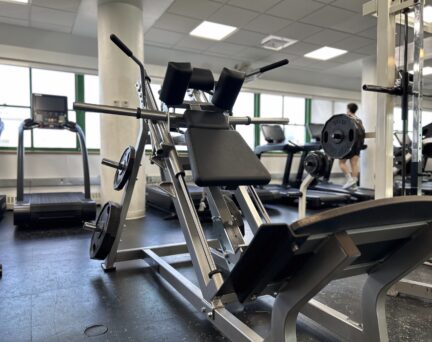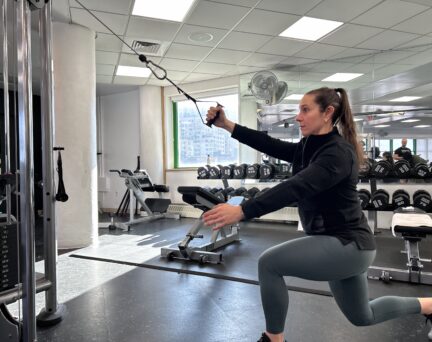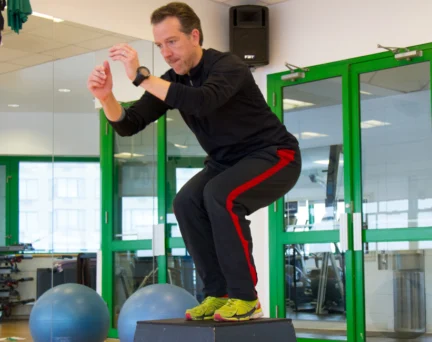The Beginner’s Guide to the SkiErg

You may be familiar with the rower. Well, there’s another machine in town that’s also a great way to get your heart rate up while working your muscles: the SkiErg. Like the rower, the SkiErg simulates an outdoor activity, in this case, Nordic skiing – a type of skiing that includes cross-country skiing and is a great workout that’s been around as a sporting event for hundreds of years.

But, packing your skis and trekking up a mountain isn’t the most efficient way to get in a workout. The SkiErg brings skiing indoors out of the cold and makes it possible to work skiing into your regular exercise routine. The SkiErg provides a low-impact cardio workout. It also develops strength in your entire body, especially your arms (60%), core (30%), and legs (10%).
Getting Set Up
Getting started using the SkiErg is simple. There is only one adjustment to make to the machine: choosing a damper setting.

The higher the setting, the more work you’ll have to do to pull on the handles. Our trainers recommend starting out at damper level 3 for most people. Remember, this isn’t purely a strength training machine! You don’t want to be struggling after just five or six pulls.
Once you’ve chosen a damper setting, stand back away from the flywheel. Where you stand will depend on your height. Shorter users might need to stand a little closer to the machine, while taller people will need to stand farther back. Just make sure you can comfortably reach the handles with your back straight. Place your feet shoulder-width apart. Next, grab the handles. The base of the handles will sit comfortably against the fleshy part of your palm.

Holding the handles above your head, your elbows should be extended and slightly above eye level. Reach up so that your body is in a straight line. You can stand on your tiptoes if you want. Now you’re almost ready to get going!

Using the Machine
Looking at the SkiErg, you might think you’re only supposed to pull the handles with your arms. But leverage is what’s important here. You want to make sure your whole body is involved in the motion of pulling on the handles to get the most out of your time on the machine.
From your fully extended position, flex your core and bend forward a little while slightly hinging your hips back and bending your knees. This will help you involve your glutes, hamstrings, and quads. At the same time, drive your arms down. This should all be one smooth action. Use the machine with your whole body, not just your arms. You’ll find it easier and will get a more efficient workout.

You should finish the pull with your knees and elbows slightly bent. Your hands should be next to your pockets and your triceps flexed. Be careful not to squat too low at the end by bending your knees too much. Squatting creates inefficiency and can put strain on your back. It may feel like you’re doing more work if you’re getting lower to the ground, but never bend your knees so much that your hands stop below your kneecaps.

Finally, reach back upward and straighten your body all in one smooth motion. You should return to the start position with your arms, knees, and hips fully extended. You can come up on your toes, but make sure your feet don’t leave the ground. Inhale while your chest is open, from there, you’re ready to pull again on the exhale. The goal is to create a rhythmic movement that you can keep consistent over time. Keep your core engaged while you’re working the machine and remember to keep your head level. It can feel natural to look up and down as you’re completing each stroke and follow your hands with your eyes, but that will put tension on your neck and can make you dizzy.

Beginner’s Workout
As a combination of cardio and strength training, the SkiErg can be used in many different ways. The machine can measure calories burned, speed, and distance travelled – but that’s a subject for a more advanced workout! The easiest way to start off is simply timing yourself. Pick an easy pace and push yourself to stay on the machine for five minutes.
If you’re ready for something a little bit tougher, try a high-intensity interval set on the SkiErg. For example, you could try five rounds of a 90-second sprint with 90 seconds rest in between.
If you’re ready to work the SkiErg into a strength training routine, try the following:
Three rounds with 90 seconds rest each of:
10 heavy goblet squats
10 kettlebell swings
10 push ups
Finish up with one minute on the SkiErg


